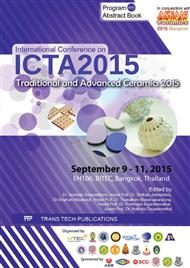p.206
p.212
p.218
p.224
p.230
p.236
p.240
p.246
p.252
Influence of Silane Coupling Agent and Nano-Filler on the Properties of Dental Resin Composite Cements
Abstract:
Dental resin composite cements were prepared with simply mixing method of Part A and Part B. The material components in Part A were composed of Bis-GMA, TEDGMA, 4-META, SiO2 nanopowders and BPO. The components in Part B were Bis-GMA, TEDGMA, 4-META, SiO2 nanopowders and 2,2¢-(4-methylphenylimino) diethanol. Before using SiO2 nano-filler in the formulation of Part A and Part B, it had to be coated with methacryloxypropyltrimethoxysilane (MPS) which served as a silane coupling agent. Therefore, the optimum amount of MPS (1, 1.2, 1.5 and 2%) and SiO2 nano-filler (20, 27.27 and 33.33 wt%) used to fabricate the composites were investigated. The homogeneous mixture of Part A and Part B at mass fraction of 1:1 was formed into the bar shape with dimension of 25 mm x 2.0 mm x 2.0 mm and then cured under light source for 20 s. Then flexural strength was measured using the universal testing machine. Depth of cure was tested using mould which was perforated in cylindrical shape of 6 mm in depth and of 4 mm in diameter. The result showed that composite with 27.27 wt% of salinized SiO2 nanopowders by 1.5% of MPS showed the highest flexural strength of 65 MPa and depth of cure of more than 5 mm which were accepted according to ISO 4049. This study could be concluded that using a proper amount of MPS to silanize SiO2 nanopowders and using an optimum amount of SiO2 nanopowders significantly improved the flexural strength of dental resin composite cements.
Info:
Periodical:
Pages:
230-235
Citation:
Online since:
May 2016
Price:
Сopyright:
© 2016 Trans Tech Publications Ltd. All Rights Reserved
Share:
Citation:


